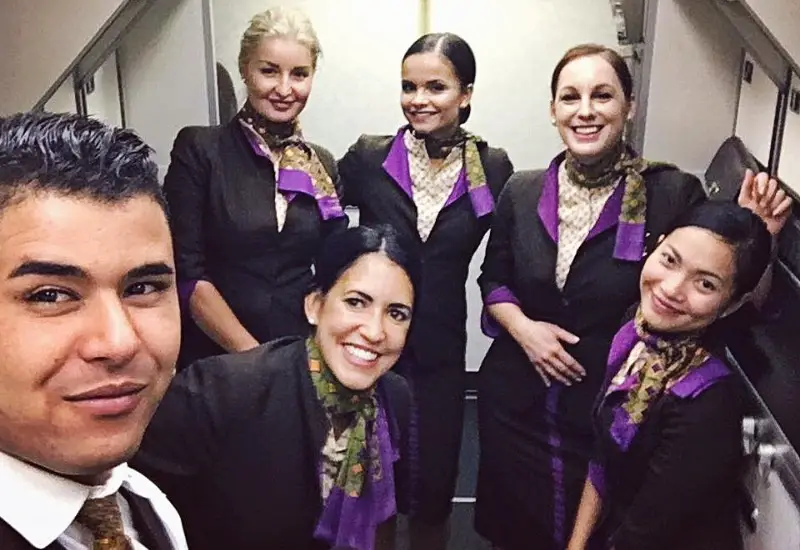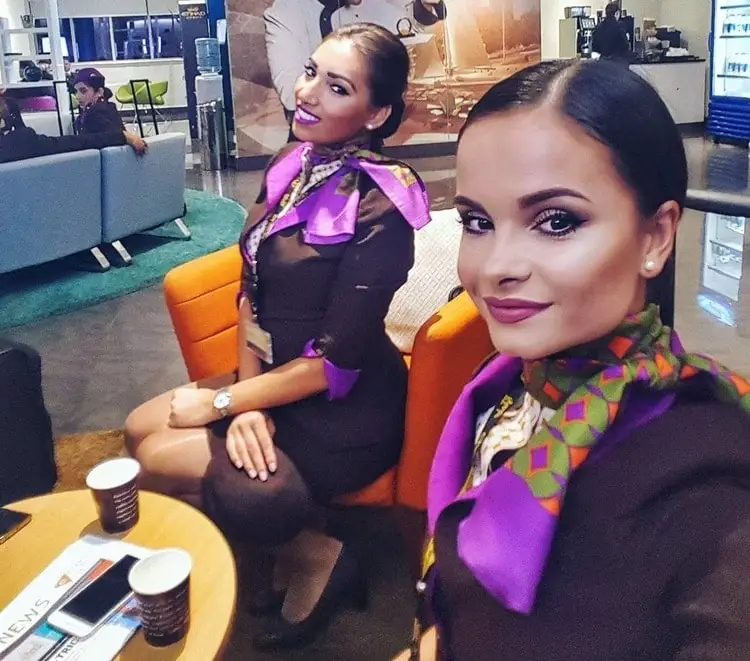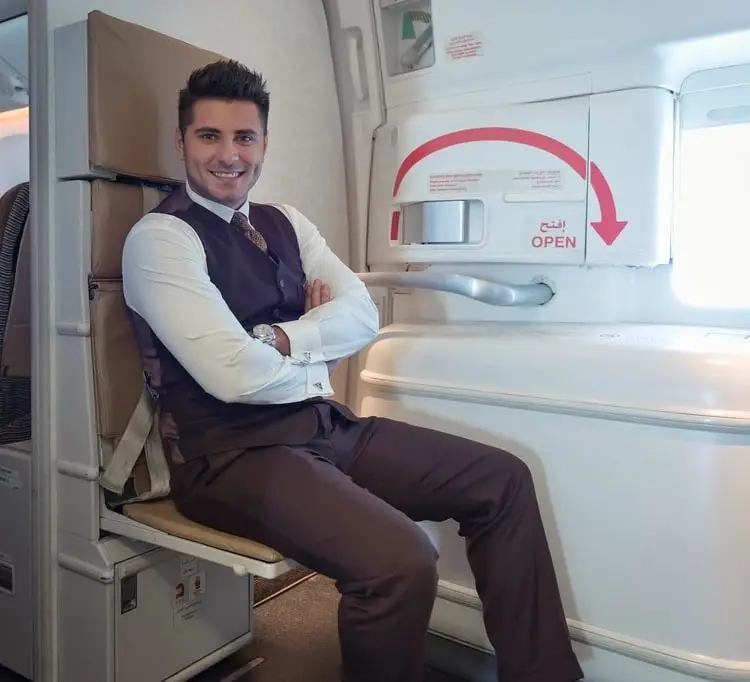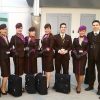
Judging by all the comments and questions that I get on this topic, it’s obvious that a lot of you guys out there wonder what a typical day in the life of cabin crew with Etihad is like.
I mean, really like.
Not just an outline of my working shift, but a blow by blow account that gives you a real flavor of what it is to work for one of the world’s best airlines.
So, in answer to these many requests, and because I think that it would be great for you to have a personal and intimate look behind the scenes, I’m going to share with you a typical working day in my life as cabin crew.
You’re going to be with me from the moment I wake up, to the moment I get back home, slip off my shoes, flop down in my favorite chair, and relax.
So where are we flying to today? Madrid!
So sit back and let’s get ready for take-off!
Wake up, get up, get ready
I need to be at the briefing center by 1.45 a.m.
Yep, you read that right, a quarter to two in the morning.
You see, the flight takes off at 3.00 a.m. and there’s a lot to do before then.
But as part of that pre-flight preparation, I’ll be meeting up with my friends and colleagues and that is one of the things that adds to the excitement and anticipation that I feel about going to work.
I need to be at the briefing center for my reporting time 1½ hours before my flight, so how do I get there?
There are no worries about unreliable taxis or the early morning lack of public transport for this girl, all I need to do is wait outside my accommodation and the shuttle bus will pick me up.
One of these free company vehicles cruises past every twenty minutes, so if I catch one at around 12.40 a.m. I’ll be sweet.
Why so early? I like to get to the airport in plenty of time and have a cup of coffee in peace. This is my early morning ‘me’ time and I love it.
Oh, just a little tip that works very well for me while I’m getting ready – music.
I play the sort of music that motivates and cheers me up while I’m doing all the necessaries like putting on my make-up and packing.
Pick Up Time
As I mentioned previously, all Etihad accommodations have shuttle buses which run every 20 minutes, so don’t freak out if you miss the first one, as long as you calculate enough time before your reporting, you will be fine!
Arriving at work
All of the crew and pilots report at the Crew Briefing Center (CBC) located right next to Abu Dhabi Airport.
Once we arrive, we go to the Kiosk computers, scan our ID’s and then answer two multiple-choice questions – one about safety and one about first aid.
If you fail to answer those correctly we get a third question which has to be right.
If this doesn’t happen, then you have to go to the Crew Briefing Officers (CBO’s) who will ask two more questions.
This really is the ‘last chance saloon’, because if you don’t get those right, then you’ll be offloaded from the flight (not allowed to fly on that day) and trust me, that really doesn’t end with a good outcome
I manage to answer all questions without any issues, so it’s time for my well deserved morning coffee!
During late nights, the Crew Briefing Center is super busy; this is because most Etihad’s flights depart between 01:00 a.m. to 03:00 a.m.
Briefing time

I’ve finished my cup of coffee and my precious ‘me’ time and I’m entering the briefing room.
It’s 01:35 a.m., and all crew should arrive for the briefing 10 minutes prior to it starting.
We’re all here and ready to start, so the Cabin Manager welcomes us to this flight and lets us introduce ourselves to each other.
That important bit of team-building done, we move on to the flight information details: passenger load, how many people are traveling with us, special handling guests, unaccompanied minors, medical cases, VIPs, special meals, how many requests are there and what are they.
I’m today’s language speaker since my mother tongue is Spanish.
After that, either the Cabin Manager (CM) or the Cabin Senior (CS) asks us safety-related questions such as, ‘Which types of doors will we find on this aircraft’, ‘What kind of slides does this aircraft have’, etc.
We now move on to learning which work position will we be scheduled on today:
- Galley operators are in charge of preparing meals and service items
- Cabin operators work -surprise, surprise – specifically in the plane’s cabin.
Shortly after this part of the briefing is over, the pilots join us and discuss the flight time and route and we’re finally ready to proceed to the E-gate – our automated immigration system.
Once everyone has gone through that, we hop to a bus that will take us directly to the aircraft.
In Abu Dhabi, we don’t need to pass through the airport to get to work.
Arriving at the aircraft, safety checks & pre-boarding duties
We’re on the plane!
The Cabin Manager announces over the Public Announcement system that we’ve got fifteen minutes to complete all our safety and security checks, so we’ve got to move quickly but thoroughly, careful not to overlook or forget a single thing.
Each crew member has to check the equipment in their area with the guidance of the CCQRH (Cabin Crew Quick Reference Handbook). That is a detailed list that tells us what to check according to the type of aircraft we’re in and our position as a cabin crew member.
We all move swiftly to do a complete check, from passenger seats to toilets, carts, compartments, and galleys.
Now on to preparing the cabin.
I work in Business class so we have to pre-set the menus, headsets, amenity kits, newspapers, and magazines before our guests board.
I and my colleague for the flight divide up the work and it’s done before the Cabin Manager has asked.
I give him the thumbs up, signaling that I’ve finished my jobs and informs the Cabin Manager “L2/R2 pre passenger boarding checks completed”.
Passenger boarding time
Ok, so boarding time is upon before we know it, so it’s HATS ON, SMILES ON, IT’S SHOWTIME!
The Cabin Manager asks an additional crew member to join him so that there are two people boarding.
So now I’m in the front galley, preparing a tray with glasses of Champagne, orange Juice, lemon mint, or water to be offered to the business class passengers as soon as they join us.
While we’re still stationary, we also take people’s coats, offer newspapers, magazines, give out warm towels, and, if time permits, we take orders for an after take-off drink and breakfast.
Cabin securing & take-off
This is the time when we make sure everything is safe for take-off: all bags are stowed, nothing is on the floor blocking the way out, toilets are empty and locked and passengers have their seatbelts on.
We walk through the cabin doing the checks and when we finish we inform the Cabin Manager and take our seats for take-off.
These seats are called “jumpseats” and can only be used by the cabin crew.
We sit there mainly during takeoff and landing but we can also use them to rest a little too if they are not located just in front of the passengers.
Jumpseats are normally located at the front and back of the aircraft and sometimes near emergency exits to be able to reach these doors in case of an emergency.

Once the captain has been notified that the cabin and passengers are secured, he announces over the PA, “Cabin crew seats for take-off”.
Time to go!
A quick mental review of the emergency procedures and voila! we’re in the air!
There’s no feeling like it, none at all.
Meal Services
By the time the ascent is over and the pilot has eased the plane into cruise mode, most of our passengers are asleep.
In Business Class I find that I don’t have very much to do, so I pop along and help in Economy where they’re handing out distribute snack bags.
On this flight, prior to landing, both cabins will have breakfast service.
This usually done one and half hours before we touchdown, so the Cabin Manager and Cabin Senior have agreed that we will start service at 5.45 a.m.
After service- Free time
After the breakfast service is finished, we finally have time for ourselves.
The flight is seven and a half hours long so we’ve got plenty of time to catch up with each other and to attend to those of our guests who are night owls.
Some crew have a bite to eat, while others take turns in doing hydration runs (giving out water in the cabin) and periodically checking the toilets.
Preparation for landing
It’s 7:30 a.m. and the First Officer has just announced that we’ll shortly be descending.
We quickly move back to the cabin to prepare and secure for landing.
We have to check that all bags are stowed, clear away any trash, make sure people have their seatbelts fastened, and that the toilets are locked.
If any guest has given us a jacket or any other item to stow for them, this is when we return it.
The Galley operators are making sure all service containers, bars, and carts are closed and sealed and the galley is also secured.
Once we all agree that everything is secured we take our seats for landing and inform the cockpit via the interphone.
Landing
Wow! This part is almost as wonderful as taking off.
As I look out the window, I can see a beautiful sunrise over Madrid.
Glorious, just glorious.
I’m starting to wonder what I should eat for my own breakfast when I get interrupted by the Captain’s announcement: ‘Cabin Crew seats for arrival’.
Once again it’s time to mentally review my emergency procedures for landing.
We do this because 80% percent of accidents happen during the takeoff or landing phases of the flight, so it’s important to be ready to react fast.
I don’t mean to alarm you, but that’s a reality, and being prepared for the unlikely event of it happening is a very, very important part of a flight attendant’s job.
We are more than just pretty faces, way more.
Disembarkation & airport arrival
Bye, thank you! Thank you, bye-bye, Merci. Gracias. You’re welcome. Have a lovely day.
The last passenger is leaving the plane and we rush to collect menus, blankets, headsets, and unused amenities from the seats, the floor, and anywhere else that our guests may have left them.
As part of the post passenger disembarkation checks, we ensure that all containers are sealed and that everything is perfect. Once that is done, we inform the Cabin Manager and it’s time to leave the aircraft.
We check our grooming to make sure we look decent and we head outside.
As we walk through the airport we have so much energy that it feels as if we’ve just woken up!
We show our ID’s to the Immigration officers, head on to pick up our suitcases, and then outside to wait for the bus.
Our shift is finally over!
Arriving at the hotel
As we are standing at check-in, I can hear some people making plans for lunch or dinner but this time I’m not joining them because I’m going to see my friends.
Once I’ve got my key, I head up to my room, take a shower, change out of my uniform and go back down for breakfast.
I’ve been awake for almost twenty-four hours, but a quick nap afterward will soon sort that out for me. In our job, you get used to living on the fringes of normal hours.
Frequently Asked Questions
What you do when on layovers? How long was this one? And usually how long they can be?
This layover was 24 hours. Depending on how tired I am and the destination, I either go to the city or just go to the nearest supermarket and come back to the hotel.
In Etihad, layovers range from between 24 to 72 hours.
What is your favorite destination?
My two favorites are Madrid and Seychelles
How do you deal with jetlag?
By trying to stay awake until it’s sunset in the city where I am.
Also, exercising helps a lot!
What is the best thing about the job?
Traveling to amazing cities and working with different people every day.
What is the worst thing about the job or is there something you don’t like about working in Etihad Airways?
I dislike the changes in our sleeping patterns. Sometimes we are overly tired and can’t sleep properly.
Also, I’m not a great fan of the physical strains that the job has on our backs. After a while, lifting things can really hurt your spine.
How many days do you have to work on average? How many days off do you have on average in a month?
For every 7 days of work, we have 2 days off.
On average, a cabin crew has from 10 to 15 days off every month.




Thank you for this vital information…much appreciated 👍 Hopefully my daughter will be joining this wonderful airline soon and work with wonderful people like yourself.
Lovely detailed information